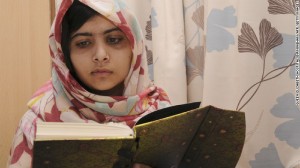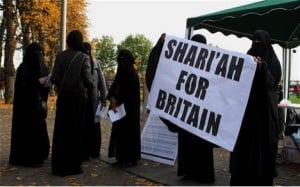This post was written by guest contributor Ossob.
Looking back at recent media attention on Muslim women, the story of Malala Yousafzai stands out because it simultaneously inspired and frustrated me. A young Muslim woman had captured the attention of the global media for, it would appear, all the right reasons. Malala Yousafzai, the bright 14-year-old activist brutally attacked by the Taliban, has not fit neatly into the dominant narrative of Muslim women as oppressed, feeble, and silent. Her triumphs and trials have inspired the world and elevated her to near sainthood. But the ensuing media frenzy has buried the complexities and nuances of her story under mounds of simplification and speculation. Major Western news networks have taken the lead in conveniently glossing over contextual realities. In response, many have rejected the feel-good story to expose the hypocrisy of Western selective outrage and to bring a more critical perspective to the coverage.
Elements of the Western media took a particular liking to Malala’s story, which could be attributed to their weakness for headliners involving brown women of the global south overcoming adversity. Malala’s story was probably even more appealing because the adversity was none other than the Taliban, the west’s sworn enemy and the epitome of Islamic barbarity. It was the perfect recipe for a story to go viral and soon enough, campaigns and funds, were dedicated to Malala’s heroism. Celebrities and renowned political figures were also paying homage. Former prime minister of the UK Gordon Brown has written several articles on her. His articles rarely (if at all) take into consideration the effects of the war on terror in which his country is still actively engaged. Madonna gave a shout out to Malala during a concert and then dedicated a striptease to her, which was alleged to be a “naked publicity stunt,” aside from also being glaringly inappropriate and narcissistic.

Regarding how Pakistani media are processing the coverage of Malala, here is an interesting article critiquing the accusation that Malala’s attack is a foreign conspiracy to insult Pakistan and to bolster the US. This article also addresses questions that many in Pakistan and beyond have considered. Why did Malala’s plight create such a buzz while similar children who have died from American drones are ignored? Why did Malala get special treatment in a UK hospital while others suffer without any treatment at all? One Pakistani writer expresses how such questions can lead to sensational and unhelpful distractions from the serious problem of the Taliban and girls’ education. The same writer condemns “inject[ions] [of] complexity” as inappropriate and that more energy should be spent on protecting and providing for Pakistan’s children rather than scapegoating Pakistan’s problems on the west. As this MMW post aptly shows, there has been a lively and diverse debate on what Malala’s story means for Pakistan. But it is understandable why there is controversy. The simple truth is that if Malala were injured by a drone instead, her fate would have been very different. Powerful networks of Western media (such as CNN which has been criticized for being a mouthpiece for US foreign policy) seem to love this story because it fits theirs: “The Taliban is the ultimate villain here; please continue to ignore our own role!”
The politicization and simplification of Malala by both Western and non-Western media equally serves to obscure the full story. Drones and aggressive US foreign policy have been underplayed despite being significant factors in the general Pakistani socio-political landscape, which Malala is a part of. But conspiracy theories have been used to dismiss the real struggles of girls to lead dignified lives in Pakistan. Overall, the mainstream media has failed to be investigative, which is its job. Many of those in power, including the US, Pakistan and the Taliban, are not interested in exposing (much less engaging with) the realities that Malala’s story reveals. The Taliban’s extremism, the Pakistan government’s corruption and subservience to US military whims and the US’s dangerous interventions are all implicated in those realities. It is much easier to portray Malala’s story in whatever way most deflects that blame and responsibility. Thus, it is left to us to add the gray into a story deceivingly, and intentionally, made black and white.












